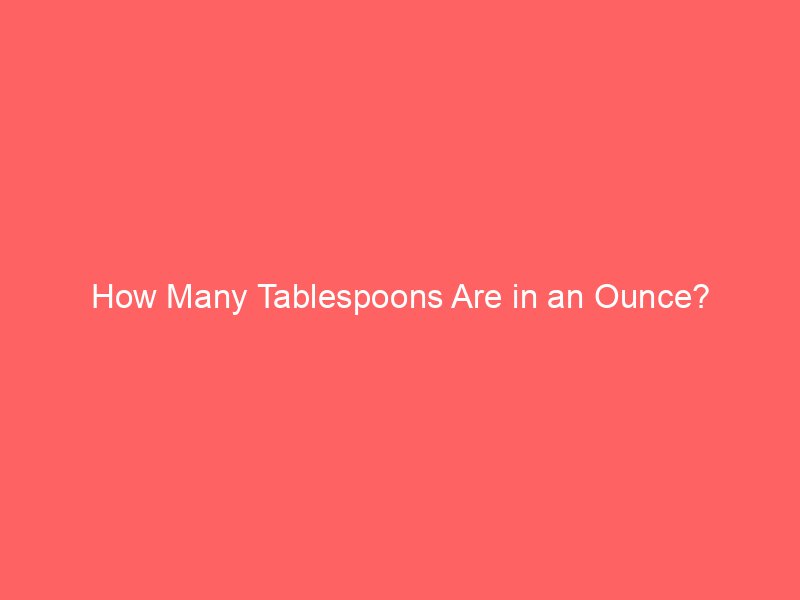There are 2 tablespoons in one fluid ounce. This means if a recipe calls for 1 ounce of liquid, you’ll need 2 tablespoons to match that volume. For larger amounts, simply multiply: 2 ounces equal 4 tablespoons, 4 ounces equal 8 tablespoons, and so on
Understanding the Basics: Ounces and Tablespoons
Before jumping into conversions, it helps to know what these units actually represent. An ounce can mean different things depending on context: a fluid ounce measures volume, while a dry ounce measures weight. Here, we focus on fluid ounces, which are common in recipes for liquids like milk, oil, or water.
A tablespoon is a volume measurement used widely in cooking. In Canada, it’s generally the same as in the US-about 15 millilitres. So, when we say 1 fluid ounce equals 2 tablespoons, we’re talking about volume, not weight
Why Does This Matter in the Kitchen?
Precision in measurements can make or break a recipe. Imagine baking a cake and adding too much or too little vanilla extract because you misunderstood the measurement. Knowing that 1 fluid ounce equals 2 tablespoons helps avoid these pitfalls.
For dry ingredients, the conversion is trickier because weight varies by ingredient density. For example, 1 ounce of flour won’t equal 2 tablespoons by volume. But for liquids, this conversion is reliable and straightforward
Tablespoons to Ounces: Quick Reference Chart
| Fluid Ounces (fl oz) | Tablespoons (tbsp) |
|---|---|
| 1 | 2 |
| 2 | 4 |
| 3 | 6 |
| 4 | 8 |
| 5 | 10 |
| 6 | 12 |
| 8 | 16 |
This chart simplifies quick conversions without pulling out a calculator
Common Mistakes to Avoid
Many confuse dry ounces with fluid ounces. A dry ounce measures weight, while a fluid ounce measures volume. This distinction matters when converting tablespoons to ounces for ingredients like sugar, flour, or nuts.
Another common error is using tablespoons interchangeably between US and Canadian measurements. While close, slight differences exist: a Canadian tablespoon is typically 15 mL, matching the US tablespoon, but some older Canadian recipes might differ. Always check your measuring tools for accuracy
Practical Tips for Canadian Kitchens
- Use a liquid measuring cup for fluid ounces and tablespoons. It usually has clear markings and a spout for pouring.
- When measuring dry ingredients, use dry measuring cups and spoons to avoid packing or air pockets that alter volume.
- For recipes from the US, remember that fluid ounces and tablespoons are the same, so conversions apply directly.
- If you’re converting recipes from the UK or Australia, note their tablespoon sizes differ (20 mL in Australia), so adjust accordingly.
Why Recipes Use Tablespoons and Ounces
Tablespoons offer a convenient way to measure small liquid volumes without needing a full measuring cup. Ounces, especially fluid ounces, provide a standard unit for liquids in recipes and nutrition labels.
In Canada, recipes often mix metric and imperial units. Knowing how to convert between tablespoons and ounces helps you follow recipes accurately, whether they use millilitres, cups, or ounces
When to Use This Conversion
- Pouring salad dressings or sauces where tablespoons are easier to measure.
- Adjusting ingredient amounts in recipes that list ounces but you only have tablespoon measures.
- Scaling recipes up or down without losing track of liquid volumes.
How to Measure Tablespoons and Ounces Correctly
Use level tablespoons, not heaping ones. A tablespoon should be filled to the brim and leveled off with a knife for accuracy.
For fluid ounces, use a clear measuring jug or cup. Pour the liquid to the correct line at eye level to avoid misreading.
Final Thoughts
Knowing that 1 fluid ounce equals 2 tablespoons makes cooking simpler. It’s a handy conversion that saves time and keeps recipes on track. Whether you’re stirring up a sauce or baking a batch of cookies, this knowledge helps you measure confidently.
This article provides clear, practical information tailored for Canadian kitchens, avoiding confusion between volume and weight measurements, and ensuring recipes turn out just right.
